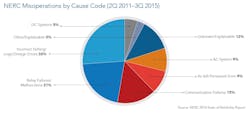Misoperations Degrade Reliable Performance of the Power System
Nearly all major system failures, excluding those caused by severe weather, include misoperations as a contributing factor. Misoperations often make system disturbances even more severe than if the protection system had operated correctly.
The North American Electric Reliability Corporation (NERC) is the regulatory authority whose mission is to assure the reliability of the bulk power system. Under NERC’s mandatory standards, utilities are obligated to review all protection system operations to identify those that are misoperations. The utility obligations include:
- Analyzing misoperations of protection systems to identify the cause(s).
- Developing and implementing corrective action plans to address the
causes of misoperations.
Misoperations Still Continue to Contribute to Poor Reliability
NERC has been reporting on misoperation performance for several years. The most recent NERC 2016 State of Reliability Report states that while the performance of protection system operations improved over prior years, misoperations continue to be one of the largest contributors to transmission outage severity and should remain an area of focus.
- The rate of misoperations, as a percentage of total operations, is just under
10% (i.e., roughly one in 10 protection system operations involves a misoperation). - In the past three years there has been some improvement in misoperations
performance - The most common causes of misoperations have remained the same through
the past three years with over 60% percent of misoperations caused by
settings/logic/design errors, communication failures, and relay malfunctions. - A misoperation includes Failure to Trip, Slow Trip and Unnecessary Trip as
defined in the NERC Glossary of Terms.
Peer Reviews will Help Reduce Protection System Design Errors
Since a significant source of misoperations is a result of relay settings errors, one approach to reducing these errors is to implement peer reviews of composite protection system design and the settings used in each composite protection system. Extensive guidance is available through NERC technical committee reports such as NERC Analysis of System Misoperations.
Example: Reducing Relay Settings Errors
To reduce the number of relay setting errors the following steps can be taken:
- Independent peer reviews of composite protection
system designs and settings. - Use of industry guidelines and standardized design
and setting approaches. - Increased training in protection system design and
setting development. - More detailed fault studies.
- Standard templates for setting standard protection schemes using complex relays.
- Proactive periodic review of existing settings prior
to changes in system topography.
Peer reviews are a useful tool for both training and performance improvement. Periodic independent peer reviews can consist of verifying that the relay settings meet the specifications of the relay and control application.
When new relays are installed or major changes are made on existing relay schemes, a peer review should be performed by a person that has equal or greater experience than the person that prepared the settings to verify that the relay settings meet the specifications of the relay and control application.
Increased training will help reduce the numerous calculation and application misoperations discovered during analysis. More detailed fault studies and periodic review of existing settings are crucial to ensure that changes to the system do not result in misoperations. The IEEE Power System Relaying Subcommittee (PSRC) has published a working group report Processes, Issue, Trends and Quality Control of Relay Settings to provide additional technical guidance for quality control of protective relay settings.
What Your Company Can Do?
Be proactive. Having detailed and well thought out P&C design standards and a Quality Control Plan is an important proactive step toward reducing the number of future misoperations.
Be a learning organization. When a misoperation occurs conduct an in-depth review of all protection system operations. Where misoperations are identified, create action plans to analyze and determine the cause. Having independent end-to-end review of the design of composite protection systems that have been identified as having misoperated will contribute to improved protection system performance.
Reviewing each operation and identifying misoperations is mandatory under NERC Standard PRC-004-4(i). This standard mandates reviews of misoperations and calls for development of corrective action plans when misoperations are detected. These corrective action plans may be limited to the composite protection system that has misoperated, or may be generic and result in system wide obligations for correction of similarly designed protection systems. The outcome depends on the findings as to the cause of the misoperation. Each misoperation is a learning opportunity that should be taken advantage of.
Taking these steps will contribute to the industry goal of improving reliability, reducing the severity of system disturbances and fulfil the mandatory obligations to examine, report and correct all protection systems that have experienced misoperations.
Content provided by TRC. For more information contact:
Timothy Farrar • Augusta, ME • Chief Engineer—Protection and Controls • 207.621.7027 • [email protected]
Stephen Persutti • Rocky Hill, CT• Vice President of Utility Development • 860.202.4244 • [email protected]
Stay Connected with TRC





